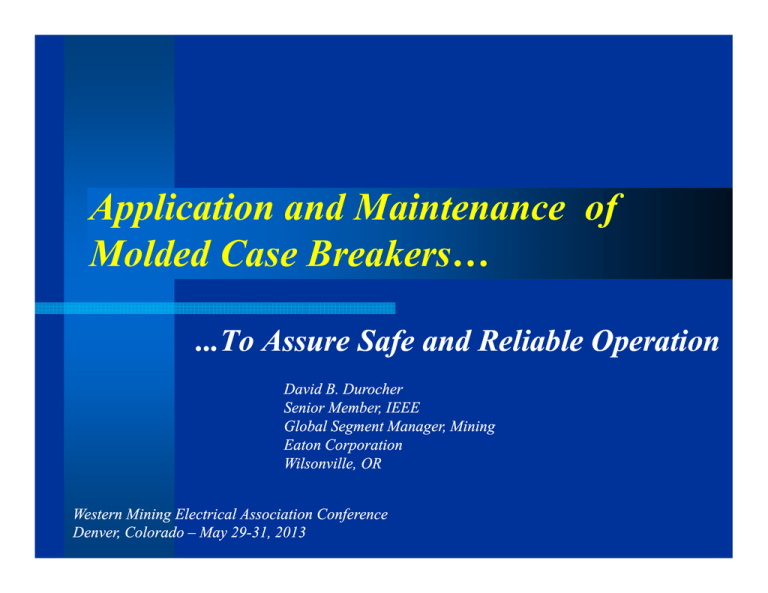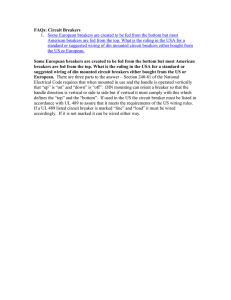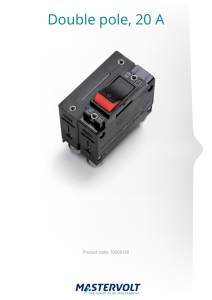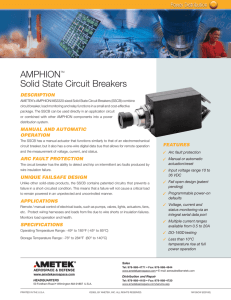Application and Maintenance of Molded Case Breakers…
advertisement

Application and Maintenance of Molded Case Breakers… ...To Assure Safe and Reliable Operation David B. Durocher Senior Member, IEEE Global Segment Manager, Mining Eaton Corporation Wilsonville, OR Western Mining Electrical Association Conference Denver, Colorado – May 29-31, 2013 Why We Authored This Paper… There are a few concerning assertions out there • • • Assertion 1: “Several studies have revealed that circuit breakers that were not maintained within a period of five years have a 50% probability of failure” Assertion 2: “If a breaker has not been operated within as little as 6 months, it should be removed from service and manually exercised” Assertion 3: “Maintenance of molded case circuit breakers is limited to proper mechanical mounting, electrical connections and periodic manual operation” Why We Authored This Paper… There are a few application myths out there • • • • • Myth 1: It is necessary to derate the nameplate interrupting rating of Molded Case Circuit Breakers (MCCBs) Myth 2: MCCBs have a history of inherent nuisance tripping problems when applied in motor circuits Myth 3: Circuit breakers take longer to clear a fault than other types of overcurrent protective devices Myth 4: Only more sophisticated current limiting design breakers will limit let-through current during a fault interruption Myth 5: Single pole interrupting capabilities of MCCBs restrict applications where these devices can be safety applied Why We Authored This Paper… To de-mystify MCCBs and share best practices • • • • MCCBs are subjected to rigorous testing standards to assure long-term reliability Although typically in a factory sealed molded case, there are several ways to determine the condition of a MCCB Test standards exist that offer excellent step-by-step instructions on ways to field test MCCBs Field based infrared thermography has proved an excellent predictive tool in identifying potential problems with MCCBs that are installed and operational Framing the Issues… MCCBs are comprised of five major components • • • • • Molded case or frame Operating mechanism Arc extinguishers Contacts Trip components Framing the Issues… Ceding the point: It is often difficult to determine when a MCCB should be considered as a candidate to be replaced • • • Most MCCBs are in sealed cases – breaking the seal jeopardizes manufacturer’s warranty Internal damage that may occur during repeated high level fault current interruption could affect the breaker’s ability to interrupt a future fault Electrical safe workplace standards (NFPA70E) assume a MCCBs will function as intended, regardless of age, maintenance history, or condition MCCB Codes & Standards UL489: Molded-Case Circuit Breakers, MoldedCase Switches, and Circuit-Breaker Enclosures. Standard Tests – 225A • Endurance: cycled 8,000 operations – 4,000 under load • Overload: cycled 50 operations @ 600% rated current • “Limited” Fault Current: 2 interruptions @ 10kA for 225A • “Maximum” Fault Current: 2 interruptions @ rated MCCB Codes & Standards NEMA Standard AB4: Guidelines for Inspection and Preventive Maintenance of Molded Case Circuit Breakers Used in Commercial and Industrial Applications • • • The first industry standard (1991) covering MCCB maintenance, written by manufacturers Focus on inspection, preventive maintenance, and test procedures for MCCBs that are in service Latest issue 2003, free download at http://www.nema.org/ MCCB Codes & Standards IEEE Standard 1458: Recommended Practice for the Selection, Field Testing, and Life Expectancy of Molded Case Circuit Breakers for Industrial Applications • • • • PAR originally sponsored by the IEEE IAS Petroleum & Chemical Industry Committee Procedures for field testing and determining the remaining life of molded case circuit breakers First introduces thermography as a useful predictor of MCCB condition First issued 2005 Photo from IEEE 1458 MCCB Application Myths versus Facts A. Is it necessary to always derate the MCCB interrupting rating? NO! • • • MCCBs are subjected to UL489 tests to prove them safely capable of interrupting multiple fault currents The UL489 test standard requires MCCBs to interrupt their maximum nameplate fault current twice Exception: Consider derating of MCCB interrupting ratings when applied on corner grounded delta connected systems MCCB Application Myths versus Facts B. Do breakers have a history of inherent nuisance tripping problems in motor circuits? They did… this was resolved with a NEC change • • National Electrical Code Article 430.51 (NEC) has historically recognized the application of magnetic-only MCCBs in motor circuits, but has limited the maximum magnetic setting to 13 times the motor rated full load current. 2005 edition of the NEC was the first to allow breaker magnetic trip setting to be as high as 17 times for Design B energy-efficient motors MCCB Application Myths versus Facts C. Don’t circuit breakers take longer to clear a fault than other types of overcurrent protective devices? NO! • Most MCCBs clear sub-cycle, when operating in their instantaneous range 0.007 seconds MCCB Application Myths versus Facts D. Only more sophisticated current limiting design breakers will limit let-through current during a fault interruption. NO! • • • • Newer MCCBs employ a reverse-loop design Higher currents = higher forces Trip free Dynamic impedance Arc Impedance MCCB Application Myths versus Facts E. Don’t single pole interrupting capabilities restrict applications where MCCBs can be safety applied? An old topic that seems to never die.. • • • • UL489 single pole test is 10kA But, a single pole of MCCBs are generally not called upon to clear phase voltages To be a concern, a second fault on a different phase and on the source side would need to occur simultaneously (HRG) Exception: corner grounded delta connected systems 480V Wye Source 1 AØ BØ N HRG CØ 2 3Ø Load Application of Thermography IR Surveys at NW Paper Mill • • • Thermal Imaging has been used at the mill site for the past 10 years. Company employees are deployed to do this work Many applications for IR, electrical and otherwise, have proven successful STEAM TRAP SURVEY TMP TRANSFORMER HEATERS PV ROLL FAN BELT SLIPPING Application of Thermography IR Surveys at NW Paper Mill Bill’s Horse! • IR Scan proved more reliable that Doctor’s diagnosis! Application of Thermography IR Surveys at NW Paper Mill • • • Thermal scans for electrical equipment conducted twice/year MCCBs in low-voltage MCC units are part of the survey Thermographer wears appropriate PPE while in the flash protection boundary PM#1 – Commissioned 1978 PM#2 – Commissioned 1980 PM#3 & Deink – Commissioned 1990 Application of Thermography IR Surveys at NW Paper Mill • 2002 experience sending MCCBs back to the manufacturer’s Product Integrity Center (PIC) yielded encouraging results! Application of Thermography Test Case #1: 150 ampere MCCB 4919-2 • • • January 2008 IR scan identified 149.4oF hot spot temperature Temperature above the IEEE 1458 Standard of 130oF. Removed from service and returned to PIC for further analysis Application of Thermography Test Case #1: 150 ampere MCCB 4919-2 PIC Photos – visible wear PIC Test Data – confirmed hot spot Application of Thermography Test Case #2: 150 ampere MCCB 4919-4 • • • January 2008 IR scan identified 130.8oF hot spot temperature Temperature above the IEEE 1458 Standard of 130oF. Removed from service and returned to PIC for further analysis Application of Thermography Test Case #2: 150 ampere MCCB 4919-4 PIC Photos – visible wear 163.1oF PIC Test Data – confirmed hot spot Application of Thermography Test Case #3: 150 ampere MCCB 4919-1 • • • January 2008 IR scan identified 171.8oF hot spot temperature Temperature above the IEEE 1458 Standard of 130oF. Removed from service and returned to PIC for further analysis Application of Thermography Test Case #3: 150 ampere MCCB 4919-1 142.3oF PIC Photos – less visible wear PIC Test Data – no hot spot found! Application of Thermography Test Case #4: 150 ampere MCCB 4919-9 • • • June 2008 IR scan identified 105.9oF hot spot temperature Temperature below the IEEE 1458 Standard of 130oF. Removed from service and returned to PIC for further analysis Application of Thermography Test Case #4: 150 ampere MCCB 4919-9 PIC Photos – external pole A discolored PIC Test Data – hot spot found! Application of Thermography Other overcurrent protective devices • • • • Paper Machine #1 area, built 1979 MCCBs included current limiters IR scans also useful here - 249.6oF! - 3 of 4 elements melted! “Aged” limiter removed from service Other Off-Line Breaker Testing Methods Rotational outages – 5 week intervals • • • • Lockout and tagout procedure for equipment maintained during the period MCCBs in the respective operating area may be mechanically exercised and the trip system tested via the push-to-trip feature General condition of each circuit breaker is noted External condition of the outer case may warrant immediate replacement or subsequent spot thermographic inspection after the equipment is back in service. Circuit Breaker Reliability Results Using the UL489 50oC Rise Threshold 11 MCCBs removed from service in one-year period from a total population of 876 operating in PM # and Deink area Of the 11 MCCBs returned to the PIC, 5 demonstrated test temperature rise above the 50oC threshold Good overall reliability. 5 of 876 breakers = 0.57%! Circuit Breaker Reliability Results Additional Observations None of the 11 breakers returned to the PIC actually failed! Mechanical operation and trip system verified Perhaps up to 7 of those field surveyed did not require immediate replacement - results recorded hot spot temperature below 130oF Erring on the side of caution not uncommon in a continuous process environment! Ideas to Improve This Process Better discipline in exercising breaker using push-to-trip feature Record fault current magnitudes with substation meter waveform-capture Circuit Breaker Applications & Arc Flash An Arc Flash - An electrical arc due to either a phase to ground or phase to phase fault. Caused by many factors - dropped tools, improper work procedures, etc. 80 percent of all electrical injuries are burns that result from the electric arc flash Arc flashes cause electrical equipment to explode, resulting in an arc-plasma fireball Solid copper vaporizes, expands to 67,000 times its original volume Temperatures exceed 35,000 degrees F Detected sound levels of 141.5 decibels Pressure levels of 2,160 pounds per square foot Arc Flash & PPE National Fire Protection Association NFPA 70E-2012 Will this become a global Standard? Addresses electrical safety-related work practices Developed in cooperation with OSHA, to fulfill their needs. Assumes an NEC compliant installation. 1979: First published, 1995: Added Flash Protection Boundary 2000: Focused on use of personal protective equipment (PPE). 2004: Emphasizes safe work practices. 2009: Energized work permits, Adopted in parts of APAC & LAM, Harmonized CSA Z462 introduced 2012: Newest edition released October 2011 National Fire Protection Association NFPA 70E-2012 Article 130.3 National Fire Protection Association Standard 70E-2012 “Standard for Electrical Safety in the Workplace” First published in 1979 – Established at the bequest of OSHA. 130.3 Arc-Flash Hazard Analysis “A flash hazard analysis shall be done…” 130.3 (B) Personal Protective Equipment (PPE) “… Where it has been determined that work will be performed within the flash protection boundary by 130.3(A), the flash hazard analysis shall determine, and the employer shall document, the incident energy exposure of the worker (in calories per square centimeter)… and personal protective equipment (PPE) shall be used by the employee based upon the incident energy exposure” Mr. Ouch! NFPA 70E-2012: Table 130.7 (C) (11) Protective Clothing Characteristics Hazard Risk Category Clothing Description (Typical Number of clothing layers given in parenthesis) 0 Non-melting, flammable materials (i.e., untreated cotton, wool, rayon, or silk, or blends of these materials) with a fabric weight at least 4.5 oz/yd2 (1) FR shirt and FR pants or FR coverall (1) Cotton underwear – conventional short sleeve and brief/shorts, plus FR shirt and FR pants (1 or 2) Cotton underwear plus FR Shirt and FR pants plus FR coverall, or cotton underwear plus two FR coveralls (2 or 3) Cotton Underwear plus FR Shirt and FR Pants plus multilayer flash suit (3 or more) 1 2 3 4 Required Minimum Arc Rating of PPE cal/cm2 N/A 4 8 25 40 Based upon maximum energy for a 2nd degree burn (1.2 cal/cm2) Electrical Workplace Safety Standards Summary The intent of NFPA 70E/CSA Z462 regarding arc flash is to provide guidelines which will limit injury to the onset of second degree burns (1.2 cal/cm2). Note: The heat reaching the skin of the worker is dependent primarily upon: Power of the arc at the arc location Distance of the worker to the arc Time duration of the arc exposure IEEE 1584-2002 “Guide for Performing Arc Flash Calculations” Provides guidance for the calculation of incident energy and arc flash protection boundaries. It presents formulas for numerically quantifying these values. The IEEE 1584 Guide also includes an Excel Spreadsheet “Arc-Flash Hazard Calculator” which performs the actual calculations using the formulas stated in the Guide. Unit Substation Applications Safety: Unit Substation Design Typical LV Substation with Fused Load-Break Switch Arc Flash Study Results 480Y/277V 13.8kV 1200A 3200A 1200A 2000kVA 125E 5.75%Z 1200A 1200A Fault at 480V Switchgear Bus • 31.8kA Symmetrical Fault current • 1167” AF Boundary • 702.4 cal/cm @ 18” • UNAPPROACHABLE: NFPA70E-2009: Category 4 is highest category @ 40 cal/cm Unit Substation Applications 15kV Vacuum Circuit Breaker 25”H X 20”W X 18” D, 330 lbs ANSI C37.20 Rated at 25 and 40kA 600, 1200,2000 and 2500A ratings Integral trip unit with linear trip actuator 2-step stored energy mechanism 15kV Vacuum Circuit Breaker 31”H X 29.5W X 25”D, 460 lbs ANSI C37.20 Rated at 25, 40 and 50kA 1200, 2000, 3000 and 5000A ratings External relay required 2-step stored energy mechanism Unit Substation Applications 15kV Vacuum Breaker Improved Unit Substation Design LV Substation with Retrofit Vacuum Primary Breaker 50/51 Relay 86 ST Integral 50/51 Relay Before After Arc Flash Study Results Sym. Fault at 480V Switchgear Bus 31.8kA 31.8kA AF Boundary 1167” 18” Cal/cm2 702.4 1.4 NFPA70E HRC UNAPPROACHABLE 1 Design the Hazard Out (Safety by Design) VCP-T Substation Vacuum Breaker Safety: Non PPE Unit Substation Design Typical LV Substation with Replacement VCP-T Vacuum Breaker in MSB Assembly Industry Users: P&G, Weyerhaeuser, ADM Design the Hazard Out (Safety by Design) VCP-T Substation Vacuum Breaker Substation One-Line Alternate Primary Protection LV Switchgear (3) 100:5 CT MV VCB L,S,I 600AF 3150AT ZSI 50 51 50 51 OC RELAY (3) 3150:1 CURRENT SENSORS (3) 3200:5 CT ZSI LV PCB L,S,I 800AF 800AT ZSI LV PCB L,S,I 800AF 800AT ZSI LV PCB L,S,I 800AF 800AT ZSI LV PCB L,S,I 800AF 800AT Above Ground Mining Electrical Systems North America Above Ground E-House LV Switchgear Assembly Type Tested UL1558 LV Controlgear Assembly Type Tested IEC61439-1 Up to 600 Vac Up to 690 Vac Arc Resistant Assembly ANSI C37.20.7 Arc Rated Testing ROW Internal Arc Classified Assembly IEC 61439-1 Underground Mining Electrical Systems North America ROW Some Standards No Standards Underground Power Center Standards Application? UL489 600V Max IEC60947.2 1000V Max LV Molded Case Mining Circuit Breaker 1000-1250Vac Molded Case Circuit Breakers 415/480/600V Air Circuit Breaker Various Dimensions UL489: 18 to 50kA 150 thru 2000A ratings Manually Operated Arc interruption in air 1.2kV Air Circuit Breaker - Mining Various Dimensions IEC60947.2: 8 to 25kA (to 1200V) 150 thru 2000A ratings Manually Operated MSHA 30 CFR 75 (USA) Arc interruption in air Underground Power Center Typical Schematic 15kV Switch & Fuse 2500kVA Transformer 1000V Molded Case Breakers Trend toward larger kVA ratings & higher voltages Application of Molded Case Breakers Underground Mining 15A Pilot Wire, Ground Return 3 Conductors + Ground GFM Fail-Safe Protection Ground Fault & Pilot Wire Protection UV Release Coil internal to Molded Case Circuit Breaker Operator Attempted breaker reset on power loss presents a problem Molded Case Breakers & Trip Free Standard Close Operation Main contact Contacts continue to full close position Momentum of mechanism is carried to stationary contacts Undervoltage Release Stationary contact Trip Free Operation Action happens 10X faster than standard close operation. Mechanism forces that are stored in the springs to drive crossbar motion is released and completely absorbed by mechanism causing significant stresses in the mechanism. Main contact Stationary contact Latch activated during UV condition Resolving the Application Issue Adding UV Control Power Indicator Operator confirms UV trip control power is present Only then resets the circuit breaker UV Release Control Power LED Bent Reset Pins Application of MV Vacuum Breakers Underground Mining 15A Primary Protection Underground Power Center Primary Protection Vacuum Breaker with Integral Trip Unit Arc Flash Reduction Maintenance System Third-Party Repair of Molded Case Breakers MSHA Safety Alert – April 2011 MSHA has been made aware of a hazardous condition that may exist in 600 volt and 1000 volt circuit breakers. This includes all frame sizes. The circuit breakers may appear to be new or rebuilt, but they have been changed from the manufacturer’s original design. These mining circuit breakers may have been purchased either directly from the 3rd party or through a mining supply company. …. the frames used for both 600 volt and 1000 volt have been rebuilt and may contain parts, such as tips and springs, of unknown origin and specifications. Because of the potential for injury and/or death from the failure one of these circuit breakers can cause, they should be removed from service immediately.” Third-Party Repair of Molded Case Breakers MSHA Safety Alert – April 2011 MSHA has been made aware of a hazardous condition that may exist in 600 volt and 1000 volt circuit breakers. This includes all frame sizes. The circuit breakers may appear to be new or rebuilt, but they have been changed from the manufacturer’s original design. These mining circuit breakers may have been purchased either directly from the 3rd party or through a mining supply company. …. the frames used for both 600 volt and 1000 volt have been rebuilt and may contain parts, such as tips and springs, of unknown origin and specifications. Because of the potential for injury and/or death from the failure one of these circuit breakers can cause, they should be removed from service immediately.” Manufacturer’s Authorized Breaker Service Center Factory trained personnel Genuine parts designed to manufacturer’s specifications Fully tested the repaired circuit breaker New factory warranty for the serviced product. Trends for Underground Power Centers Bigger is better! Primary voltages up to 27kV (inspired by cable costs) Transformer ratings in excess of 4000kVA Protective device interrupting ratings up to 40kA Remote open/close capability for both primary and secondary circuit breakers Application Opportunities for Higher Ratings 1.2kV Air Circuit Breaker 15”H X 15”W X 10” D, 118 lbs IEC60947.2: 8 to 25kA 150 thru 2000A ratings Manually Operated MSHA 30 CFR 75 (USA) Arc interruption in air 12/17kV Vacuum Circuit Breaker 25”H X 20”W X 19” D, 330 lbs IEC 62271-100: 25, 31.5 & 50kA 630 thru 3150A ratings Electrically Operated 2-step stored energy mechanism Arc interruption in vacuum encapsulated pole 15kV Vacuum Circuit Breaker 31”H X 29.5W X 25”D, 460 lbs ANSI C37.20: 25, 40 & 50kA 1200 thru 5000A ratings Electrically Operated 2-step stored energy mechanism Arc interruption in vacuum - vacuum bottle Sulfur Hexafluoride (SF6) The Good, … An excellent dielectric Superior insulating properties …The Bad, Colorless, odorless, 5 times heavier than air … & The Ugly! Replaces oxygen, causing suffocation The world’s most potent greenhouse gas - 23,900 times greater than CO2 Conclusions Molded Case Circuit Breakers are successfully applied in countless industrial settings Common misconception regarding application of MCCBs prevail proper application improves both safety and reliability Knowing when to remove a MCCB from service based on it’s service history can be difficult New maintenance standards including NEMA AB4 and IEEE1458 serve as useful guides in determining when to remove an MCCB from service Thermal imaging of MCCBs has been applied and verified as an excellent predictive maintenance tool Consider Substation Design alternatives to reduce arc-flash hazards Circuit breaker applications in underground mining warrant special considerations Questions? I encourage you to attend the IEEE IAS Annual Meeting Mining Industry Committee Technical Sessions October 6-10, 2013 Orlando, Florida www.ieee.org/ias2013 For More Information, Contact: David B. Durocher Senior Member, IEEE Global Segment Manager, Mining Eaton Corporation davidbdurocher@eaton.com Phone 503-582-2714 26850 SW Kinsman Road Wilsonville, OR 97070




